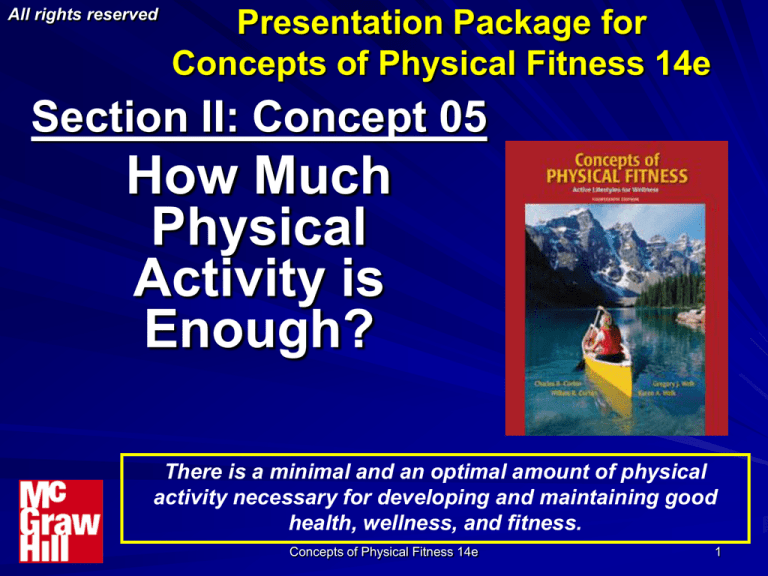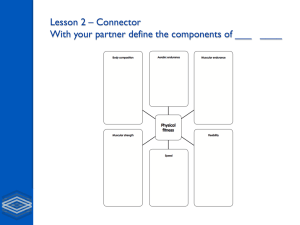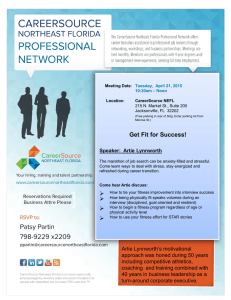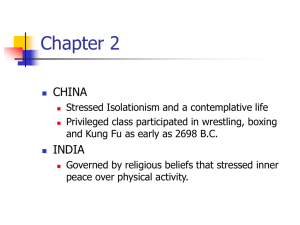
All rights reserved
Presentation Package for
Concepts of Physical Fitness 14e
Section II: Concept 05
How Much
Physical
Activity is
Enough?
There is a minimal and an optimal amount of physical
activity necessary for developing and maintaining good
health, wellness, and fitness.
Concepts of Physical Fitness 14e
1
Principles of Physical Activity
Overload Principle
Principle of Progression
Principle of Specificity
Principle of Reversibility
Dose-Response
Relationship
Principle of Diminishing
Returns
Principle of Rest &
Recovery
Principle of “Individuality”
Concepts of Physical Fitness 14e
2
Overload Principle
Most basic of all principles
Doing “more than normal” is
necessary for benefits
Muscle must work against a
greater than normal load to
get stronger
Muscle must be stretched
longer than is normal to
increase flexibility
Less overload required for
health benefits associated
with metabolic fitness.
Concepts of Physical Fitness 14e
3
Principle of Progression
Overload should occur in a gradual
progression rather than in major bursts.
Could result in excessive soreness or
injury if you fail to adhere to this
principle.
Most effective training is when sessions
become progressively more challenging
over time.
Concepts of Physical Fitness 14e
4
Principle of Specificity
Must overload for specifically what you
want to benefit.
– Examples:
Strength-training does little for
cardiovascular fitness.
Flexibility training does little for body
composition.
Overload is specific to each body part.
– Example:
Exercise legsbuild fitness in legs
Concepts of Physical Fitness 14e
5
Principle of Reversibility
Overload principle in reverse.
If you don’t use it, you will lose it!
Some evidence exists that you can
maintain health benefits with less
physical activity than it took to achieve
them.
Concepts of Physical Fitness 14e
6
Dose-Response Relationship
The more physical activity you perform,
the more you benefit.
There are exceptions to this rule.
Concepts of Physical Fitness 14e
7
Some is Better than None!
HEALTH
RISK
OLD CONCEPT
OF TRAINING
REVISED
CONCEPT OF
TRAINING
AMOUNT OF ACTIVITY
Concepts of Physical Fitness 14e
8
More is Not Necessarily Better
Principle of Diminishing Returns
BENEFIT
EFFECT
RISK
AMOUNT OF ACTIVITY
Concepts of Physical Fitness 14e
9
Principle of Diminishing
Returns
Concepts of Physical Fitness 14e
10
Benefits of Moderate and
Vigorous Activity
Concepts of Physical Fitness 14e
11
Performance vs. Health
Improving performance requires more
physical activity than the amount
needed to obtain health benefits.
Concepts of Physical Fitness 14e
12
How Much is Enough?
OPTIMAL
AMOUNT
HEALTH
HYPOKINETIC
HYPERKINETIC
ACTIVITY
Concepts of Physical Fitness 14e
13
Principle of Rest & Recovery
Rest is needed to allow
body to adapt to exercise.
Allow time for recuperation
after overload.
If no rest, could lead to
overuse injuries, fatigue,
and reduced performance.
Examples:
– Alternate hard/easy days.
– Day off between bouts of
exercise.
Concepts of Physical Fitness 14e
14
Principle of Individuality
Benefits of physical activity vary for
each person.
Individuals have unique characteristics
– Heredity
– Age
– Gender
– Ethnicity
– Lifestyles
– Current fitness and health status
– Other factors
Concepts of Physical Fitness 14e
15
FIT Formula
Frequency
Intensity
Time
See Web05-1 for
interactive FIT
prescriptions for
exercise.
Concepts of Physical Fitness 14e
16
Physical Activity Target Zone
Figure 2, p. 86
Concepts of Physical Fitness 14e
17
Physical Activity Pyramid
Concepts of Physical Fitness 14e
18
Lifestyle Physical Activity
Provides
important
health
benefits and
promotes
weight
control
Concepts of Physical Fitness 14e
19
Active Aerobics & Sports
Provides
additional
health benefits
and improved
fitness.
Concepts of Physical Fitness 14e
20
Flexibility
Promotes full range of motion in joints and
decreases risk of injuries and back pain.
Concepts of Physical Fitness 14e
21
Muscular Fitness Exercises
Maintains lean
body mass and
promotes
functional fitness.
Decreases risks
of back pain and
osteoporosis.
Concepts of Physical Fitness 14e
22
Lab 5a info
Principles from the
Activity Pyramid
No single activity provides all the
benefits.
In some cases, one type of activity can
substitute for others.
Something is better than nothing.
Activities from level 3 (flexibility and
resistance exercise) provide benefits
that are especially important for elderly.
Concepts of Physical Fitness 14e
23
Web05-4
Understanding
Physical Activity Guidelines
There are multiple sets of guidelines.
Current ACSM/CDC Recommendations:
– “Every U.S. adult should accumulate 30 min or more of
moderate-intensity physical activity on most, preferably all,
days of the week”.
=1,000 kcal/weekhealth
IOM Guideline:
– 60 min/dayhealthy body weight
Complementary recommendations,
emphasizing different goals.
Concepts of Physical Fitness 14e
Surgeon General’s
Report on Physical
Activity & Health:
Physical Activity
and Health
Executive
Summary
24
Web05-5
Physical Activity
Guidelines for Children
Different needs for activity.
NASPE/CDC Guidelines:
– 60 min to several hours of age-appropriate
physical activity on all, if not most, days of the
week.
Key Principles:
– Moderate to vigorous activities.
– Majority of time in intermittent activity.
– Minimize periods of inactivity (periods of 2 or
more hrs)
Parents/adults play a major role.
Concepts of Physical Fitness 14e
25
How Much is Enough?: Summary
Some activity is better than
none.
More activity is not
necessarily better.
Use the recommendations
that best apply to your
specific needs and goals.
Concepts of Physical Fitness 14e
26
Web Resources
Online Learning Center
“On the Web” pages for Concept
Concepts of Physical Fitness 14e
27
Supplementary Graphics
Lab Information
Concepts of Physical Fitness 14e
28
Return to
presentation
Lab 5a Information
Self-Assessment of Physical Activity
Estimate the number of
REST
days that you have
FLEX
STRENGTH
performed exercises
SPORTS
for the 3 lower levels AEROBIC
ACTIVITY
ACTIVITY
of the pyramid in
LIFESTYLE
PHYSICAL ACTIVITY
the last 2 weeks
Reflect on the consistency and
nature of your activity patterns
Concepts of Physical Fitness 14e
29
Lab 5b Information
Estimating Your Fitness
To help you better understand each of
the 11 components of health-related and
skill-related physical fitness and to help
you estimate your current levels of
physical fitness.
Perform each of the Physical Fitness
Activities to better understand each
component of fitness and help you
estimate your current fitness levels.
Do not rely primarily on the results of
the activities to make your estimates.
Concepts of Physical Fitness 14e
30








